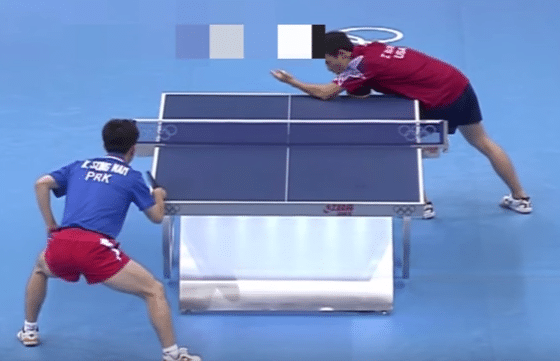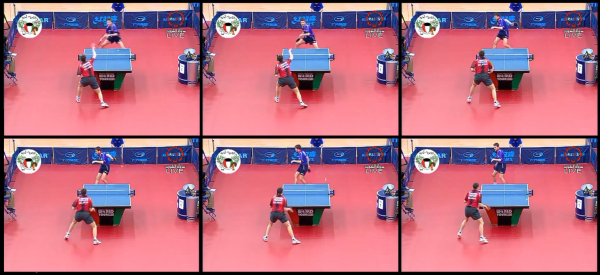Table Tennis is similar to many other sports. There are fundamental or essential shots that you should know to practice and improve. The main shots I will explain through this article are the counter-hit, block, loop, counter-loop, lob, and pushing.

These terms may seem unfamiliar if you’re starting in the sport but don’t worry, that’s to be expected, and everyone needs to start somewhere. However, by the end of this article, I am sure you will better understand what each shot requires.
Table of Contents
ToggleTable Tennis Counter-hit
It is the most basic shot for a table tennis player to have in their arsenal. It is not often used during gameplay but is an essentially shot when warming up with your opponent. You are hit the ball with your forehand diagonally to your partner’s forehand, which he reciprocates.
Table Tennis Block
Table Tennis Loop
According to the arching motion, the “loop” the table tennis ball makes as it travels through the air. Despite its strange name, the backhand and forehand loop is probably the most used table tennis shot.
It is further subdivided into “backhand loop” and “forehand loop,” where you finely stroke the ball generating topspin. This topspin results in the ball’s arching motion and results in the ball hitting the table, making it difficult for your opponent to return.
Table Tennis Lobbing
There will be times when you are pushed back from the table during play, resulting in you having to lob. Lobbing is when you hit the ball high into the air resulting in a high bounce when the ball lands on the table. Generally, you want to make the ball travel as high as possible with some added spin to the ball in pitching.
It adds a degree of difficulty to the shot and increases the chances that the opponent will either mishit the ball into the net or hit it off the table. Like most other table tennis shots, lobbing requires a lot of practice to perfect the right bounce and spin to add to the table tennis ball.
Table Tennis Pushing
The push shot is when you get underneath the ball, stroking it finely and generating spin. It is often a defensive shot used to make it difficult for your opponent to loop the ball firmly back onto the table.
Table tennis pushing is further subdivided into short pushing and long pushing. Long pushing is what we discussed above, where you push the ball long, making it difficult for your opponent to loop.
Short pushing is when you push the ball just over the net (i.e., the ball bounces twice) and is used to prevent your opponent from looping the ball. It is best described as a positional shot.
Forehand Push
Backhand Push
Shot Placement for the Win
In nearly all sports, power is valued: the hardest pitch in baseball, the hardest shot in hockey, the sharpest punch in boxing, the strongest serve in tennis.
It probably isn’t a coincidence either that the top players in each sport often exhibit that raw power trait. Nonetheless, finesse players succeed at all levels in every sport – with table tennis being no different.

A finesse player can be accurately defined as one that focuses on shot placement instead of overpowering the other player. When executed correctly, a game plan based on finesse can be successful and very difficult to play against.
One of the most effective ways to implement clever shot placement in table tennis is to find your opponent’s weakness.
The backhand is traditionally a stroke that players can generate much less power than the forehand, so consistently putting the ball there will reduce the likelihood of your opponent scoring a put-away shot on you.
Another advantage of doing this is that your opponent will often become frustrated with their inability to make a big shot and try to force something to happen – namely by trying to hit a forehand where a backhand is the only real option.
If they do this, they’ll be handcuffed and consequently put the ball in the net, off of the table or produce a weak return that you can use to take control of the point.
A second devastating weapon that players looking for vital shot placement can use is the drop shot.
If an opponent is playing back off the table and the rally consists of long strokes, simply tapping the ball over the net with no power can do wonders. Your opponent will need to try to move up to get the ball back hurriedly, and with their only priority being a safe return that won’t lose them the point right then and there, you will find yourself set up for a shot to finish the point.
How to do the “Behind-the-Back” Shot
It seems that Quentin Robinot’s behind-the-back shot against Kiril Barabanov during the Kuwait Open has gone viral! The video was uploaded on 20th February, and already it has over 1,000,000 views on YouTube. Kiril’s reaction was class!

The shot has also received mainstream media coverage, featuring on; Mashable, The Guardian, Yahoo, MSN, and The Sun. If you haven’t yet seen the video (where have you been?!) you can check it out by watching the video below.
- Rosskopf (vs Guoliang) in the 90’s – http://www.youtube.com/watch?v=H41Y0-4UReo
- Fejer-Konnerth (vs Schlager) in 2009 – http://www.youtube.com/watch?v=_3w8JNAI7ew
- Suss (vs Saive) in 2010 – http://www.youtube.com/watch?v=-RCEC4sMy0E
- Bradley Evans (my personal favorite) in 2010 – http://www.youtube.com/watch?v=3_T59Kbu2jI
The Bradley Evans one is great because of the surprise, celebration and the fact that it won him the match!
How to play the shot
If you would like to have a go at playing the “behind-the-back” shot, then here are a few tips.
- Practice it in training – It may seem like these players have just pulled this off as an instinct (which is partly true), but they’ve all also spent time perfecting the shot in the training hall. The fact that it went on is not a complete fluke. Also, you’ll never react in that way in a match unless you have some degree of muscle memory for the shot and your brain has it stored away somewhere as an option.
- Keep your bat angle closed – The natural angle of your arm as you reach behind your back will give you an open bat angle. You will realize this after the first few practice attempts. We all know that hitting the ball flat with an open bat angle will send it flying off the end of the table, so you will need to make an effort to close the bat angle to keep the shot on the table.
- Rotate your body to the right – Unless the ball is played close to your left hip (I’m writing for a right-handed player), you are going to need to rotate your body to reach the bat. By rotating/twisting your body to the right, you bring your right shoulder left and give yourself an extra 20cm of reach.
Stills from Robinot’s shot

Conclusion
If you have struggled to understand any of these concepts that I have outlined, then I would suggest you consult or discuss what you are unsure of with a coach. If you are already being coached, your table tennis coach will show you personally how to play each shot.

Warren Davies
Hi, I’m Warren Davies, a table tennis addict who loves sharing tips, reviews, and everything you need to level up your game. I’ve spent years playing, testing gear, and geeking out over the sport, and I’m here to make things simple and fun for players of all levels. When I’m not writing, you’ll probably find me perfecting my forehand or trying out the latest paddle.








